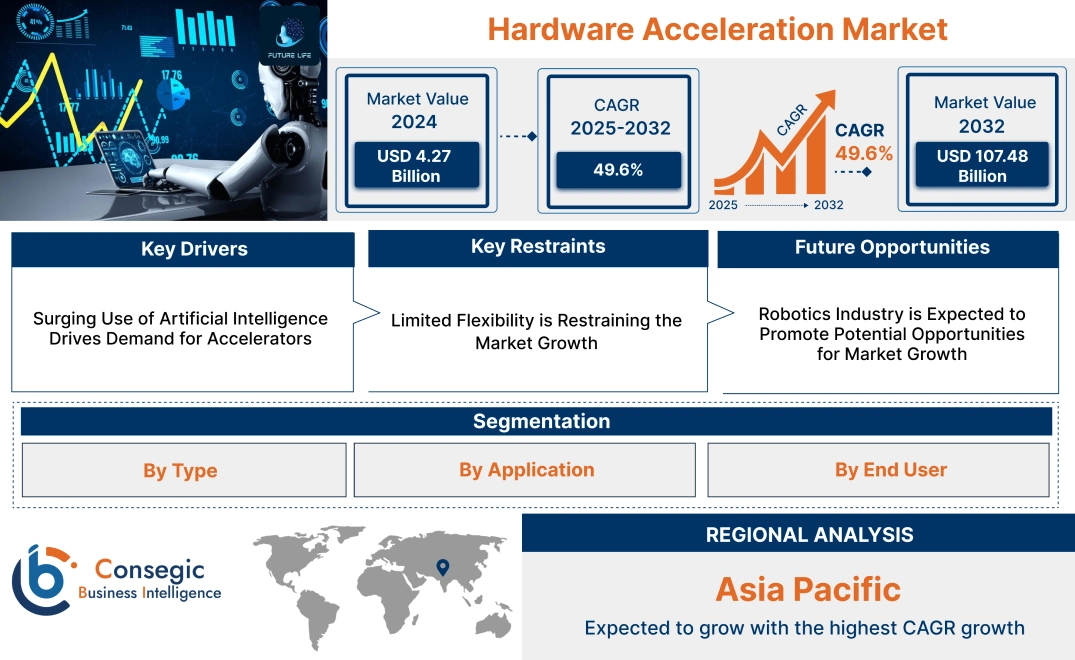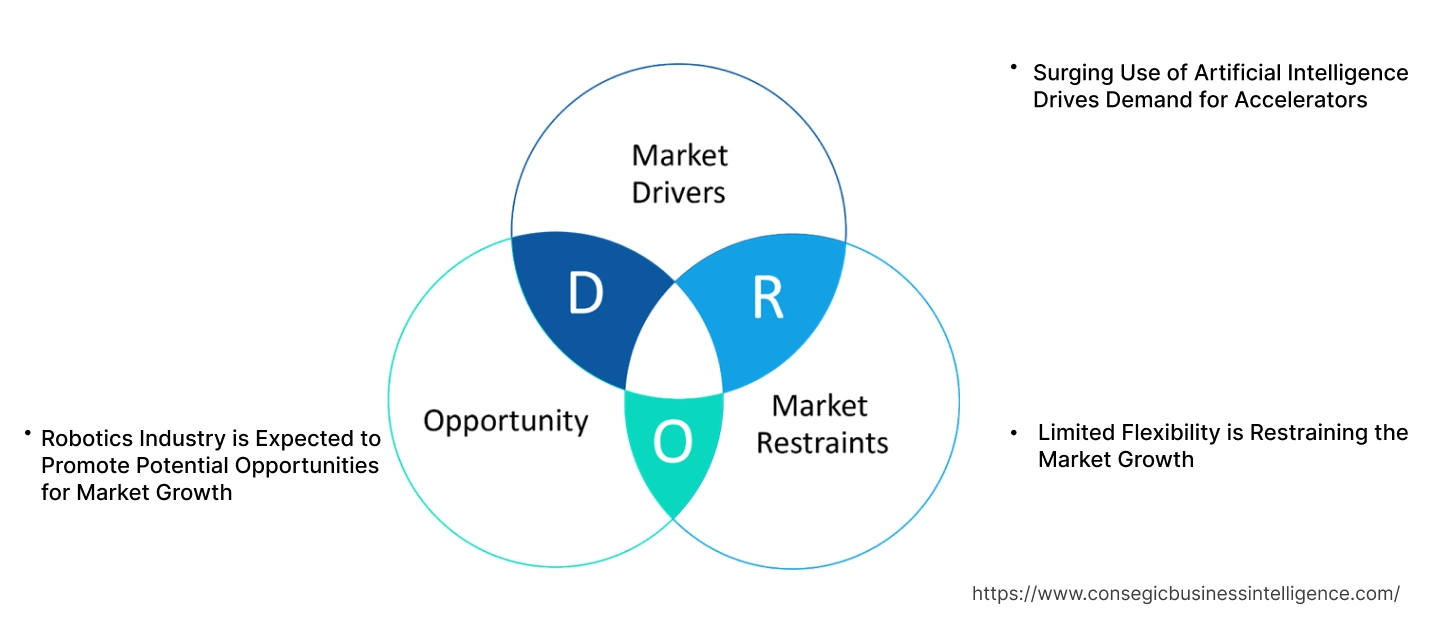- Summary
- Table Of Content
- Methodology
Hardware Acceleration Market Size:
Hardware Acceleration Market is estimated to reach over USD 107.48 Billion by 2032 from a value of USD 4.27 Billion in 2024 and is projected to grow by USD 6.32 Billion in 2025, growing at a CAGR of 49.6% from 2025 to 2032.
Hardware Acceleration Market Scope & Overview:
Hardware acceleration plays a key role in increasing efficiency by offloading computing tasks onto specialized hardware components within the system. Additionally, the most common types of hardware acceleration include DPU accelerator, AI accelerator, and Graphics Processing Units (GPUs) among others. Additionally, the accelerators are widely used in applications including deep learning inference, product design and production, and data processing & analysis among others in turn driving the market growth. Moreover, the advantages of adopting an accelerator include increased speed, improved efficiency, and reduced cost of training among others which in turn drives the hardware acceleration market growth. Also, the accelerator is widely used in graphics-intensive tasks for improving performance and enhancing user experience which is further propelling the market progress.
Key Drivers:
Surging Use of Artificial Intelligence Drives Demand for Accelerators
Hardware accelerator plays a primary role in speeding up AI neural networks, deep learning, and machine learning. The accelerators are utilized for processing large amounts of data, needed to run various AI applications such as the Internet of Things (IoT), edge computing, and more. Moreover, AI accelerators are widely utilized in data centers and edge computing frameworks which in turn is fueling the hardware acceleration market demand. Further, AI-based accelerators are used in Autonomous vehicles to enhance self-driving capabilities by interpreting data from cameras and sensors.
- For instance, in September 2024, Intel launched Gaudi 3 AI accelerators which help to deliver powerful AI systems with optimal performance per watt and lower total cost of ownership.
Thus, the rising adoption of AI in data centers, autonomous vehicles, and others is in turn driving the hardware acceleration market demand.
Key Restraints:
Limited Flexibility is Restraining the Market Growth
Hardware acceleration is prone to suffer from compatibility issues, as the software required to control the acceleration is not flexible enough to manage the emerging technologies such as IoT and machine learning which in turn hinders the hardware acceleration market expansion. Moreover, software and hardware components control the user experience and compatibility with GPUs, CPUs, and others, and reduced efficiency hinders the market progress.
Therefore, flexibility and inter-dependability are restraining the hardware acceleration market expansion.
Future Opportunities :
Robotics Industry is Expected to Promote Potential Opportunities for Market Growth
The growing need for automation in various industries is driving the demand for high-performance robots, used in autonomous mobility, industrial manipulators, and healthcare robots, among others. Moreover, an accelerator helps to react faster, consume less power, and deliver additional real-time capabilities in turn improving the overall efficiency of robots propelling the hardware acceleration market opportunities.
- For instance, in October 2024, Acceleration Robotics launched ROBOTCORE collaborative which is a human-robot interaction (HRI)-centric hardware solution. The ROBOTCORE collaborative features advanced FPGA technology and a hardware-accelerated control system.
Thus, the rising adoption of robots in various end-use industries such as automotive, consumer electronics, and others is in turn driving the hardware acceleration market opportunities during the forecast period.
Hardware Acceleration Market Segmental Analysis :
By Type:
Based on the type, the market is segmented into graphics processing units (GPUs), field-programmable gate arrays (FPGAs), tensor processing units (TPUs), cryptographic accelerators, DPU accelerators, AI accelerators, and others.
Trends in the Type:
- Data centers are increasingly leveraging DPU accelerator to improve the performance of infrastructure technologies in turn driving the hardware acceleration market trend.
- The increasing machine learning workload is driving the adoption of tensor processing units accelerator which in turn drives the hardware acceleration market trend.
Graphics processing unit accelerator accounted for the largest revenue share in the year 2024.
- The adoption of the GPU accelerator significantly speeds up video encoding, decoding, and image processing tasks, enabling faster rendering and real-time editing capabilities driving the GPU accelerator which in turn propels the hardware acceleration market share.
- Moreover, the growing emphasis on AI-specific hardware and rising adoption of AI in various applications is driving the need for GPU accelerator which in turn fuels the hardware acceleration market size.
- Further, GPUs are increasingly being integrated with edge computing, enabling real-time data processing and analysis driving the hardware acceleration market growth.
- For instance, in June 2024, Databricks partnered with NVIDIA to enhance support for NVIDIA GPU acceleration on the Databricks Platform. The partnership aims to drive the adoption of generative AI applications, or digital twins.
- Thus, the growing emphasis on AI and enhanced image processing tasks is driving the GPU accelerator.
AI accelerator is anticipated to register the fastest CAGR during the forecast period.
- The primary role of AI accelerators is to increase performance, scalability, and efficiency to meet the rising demand for high-performance devices built to handle user AI workloads.
- Further, the ability to save time and power as well as deliver simple, cost-effective AI scalability solutions is driving the adoption of AI accelerators in cloud computing, and others.
- For instance, in November 2024, IBM collaborated with AMD to develop AMD Instinct MI300X accelerators. The collaboration aims to enhance performance and power efficiency for Gen AI models such as high-performance computing applications.
- Therefore, the ability to save time and power as well as deliver simple, cost-effective AI scalability is anticipated to boost the market during the forecast period.
By Application:
Based on the application, the market is segmented into deep learning inference, product design and production, data processing & analysis, public cloud inference, inventory & supply chain management, and others.
Trends in Application:
- The trend towards the adoption of digital twin in the manufacturing industry is driving the adoption of accelerators for applications such as product design and production.
- The trends toward increasing numbers of data centers are driving the need for the hardware acceleration industry for data processing and analysis applications.
The deep learning inference accounted for the largest revenue share in the year 2024 and is anticipated to register the fastest CAGR during the forecast period.
- The advantages of adopting an accelerator in deep learning interference include reduced time, increased speed, improved efficiency, and reduced cost of training and deployment in turn fueling the hardware acceleration market.
- Further, the hardware accelerator significantly reduces the time to train and deploy deep learning models driving the need for accelerators in deep learning interference applications.
- For instance, in May 2023, MiTAC Computing Technology collaborated with Hailo Technologies to launch the MiTAC MiAi-H8 Card. The card is a hardware accelerator designed to leverage the power of artificial intelligence (AI) and deep learning inference tasks, in edge computing environments.
- Thus, according to the hardware acceleration market analysis, the aforementioned advantages of adopting an accelerator in deep learning interface applications in turn drive the hardware acceleration market.
By End User:
Based on the end-user, the market is segmented into IT & telecommunication, manufacturing, healthcare, consumer electronics, retail & warehousing, and others.
Trends in the End-User:
- The trend towards increasing adoption of autonomous vehicles is driving the need for accelerators in the automotive sector.
- The trend towards rising wearable devices that are leveraging accelerators for boosting performance and accelerating services such as video, images, music real-time processing, and streaming.
IT & telecommunication accounted for the largest revenue share of 30.10% in the year 2024.
- The IT & telecommunication sector plays a crucial role in driving the adoption of hardware accelerators to speed up the processing of transactions, optimize production processes, and improve product quality as well as render high-quality graphics.
- Further, 5G deployment is driving the demand for hardware acceleration which plays a crucial role in ensuring the efficient and reliable delivery of high-speed, low-latency communications.
- For instance, in April 2021, IEI launched a 5G network solution embedded with PUZZLE-IN005, which is a processor by Intel. The processor integrates hardware acceleration of compute-intensive workloads to maximize CPU utilization and support higher data rates.
- Thus, 5G deployment is driving the hardware acceleration market share in the IT & telecommunication sector.
Healthcare is anticipated to register the fastest CAGR during the forecast period.
- Healthcare sector is leveraging accelerators for increasing computing tasks, processing medical data, aiding diagnosis decision-making, and advanced analytics.
- Further, the CT, MRI image processing, and smart hospital data systems utilize accelerators for data processing & analysis in turn boosting hardware acceleration market size.
- For instance, in September 2022, Acceleration Robotics launched ROBOTCORE, which is used to accelerate robot operating systems. The system features ROS 2 hardware acceleration which has the ability to react faster, consume less energy, and deliver additional real-time capabilities. The robot is designed for applications including autonomous mobility, industrial manipulation, and healthcare applications.
- Therefore, according to the hardware acceleration market analysis, the rising need for data processing & analysis in healthcare is anticipated to boost the market during the forecast period.
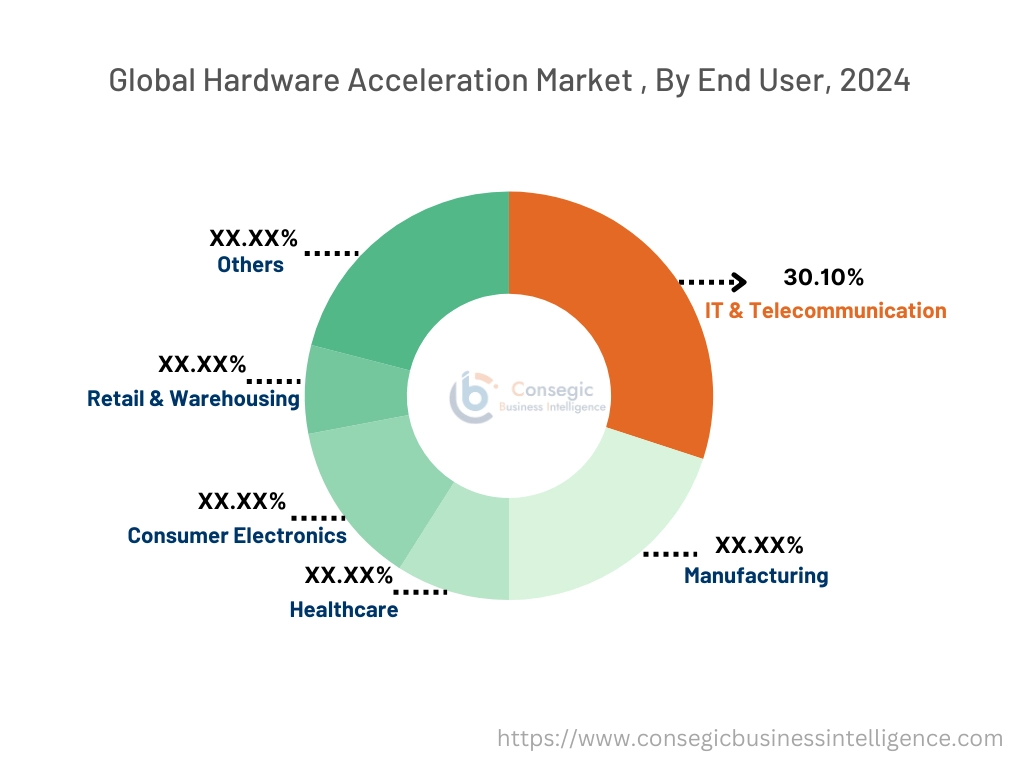
Regional Analysis:
The regions covered are North America, Europe, Asia Pacific, the Middle East and Africa, and Latin America.
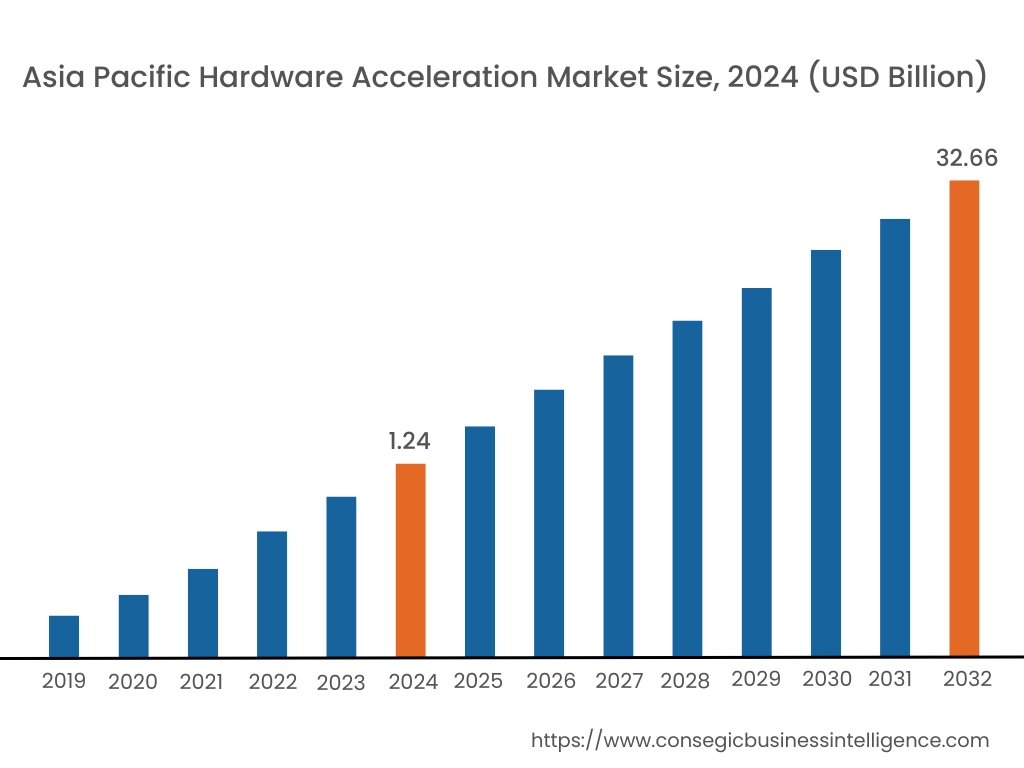
Asia Pacific region was valued at USD 1.24 Billion in 2024. Moreover, it is projected to grow by USD 1.85 Billion in 2025 and reach over USD 32.66 Billion by 2032. Out of this, China accounted for the maximum revenue share of 29.2%. The market growth for hardware accelerators is mainly driven by their deployment in data centers to improve performance and efficiency for CPU GPU and others. Furthermore, factors including the growing 5G network and connected IoT devices are projected to drive the market progress in Asia Pacific during the forecast period.
- For instance, in June 2021, Tata Consultancy Services offered a comprehensive portfolio of engineering services including TCS AI hardware accelerator, retail digital store operations framework, and others. The AI accelerator helps to improve the performance of AI applications at the Edge layer to meet real-time high-speed requirements.
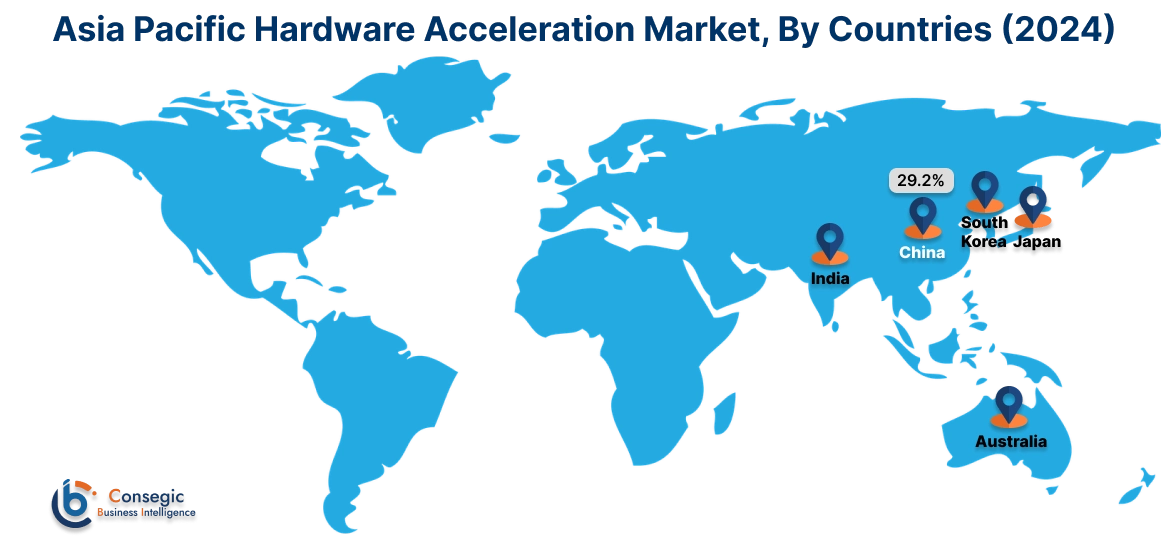
North America is estimated to reach over USD 32.83 Billion by 2032 from a value of USD 1.28 Billion in 2024 and is projected to grow by USD 1.90 Billion in 2025. The growing numbers of data centers in North America offer lucrative growth prospects for the market. Additionally, the growth of cloud computing technology and deep learning interfaces is driving the hardware acceleration market.
- For instance, in February 2024, The University at Buffalo based out in the USA, joined the AI Alliance. The alliance aims to advance the AI hardware accelerator ecosystem by boosting contributions and adoption of essential enabling software technology.
The regional analysis depicts that the increasing focus on artificial intelligence, IoT systems, and machine learning in Europe is driving the market. Additionally, the primary factor driving the market in the Middle East and African region is 5G adoption as well as growing cloud computing technology. Further, the development of deep learning technologies is paving the way for the progress of the market in the Latin America region.
Top Key Players and Market Share Insights:
The global hardware acceleration market is highly competitive with major players providing accelerators to the national and international markets. Key players are adopting several strategies in research and development (R&D), product innovation, and end-user launches to hold a strong position in the hardware acceleration industry. Key players in the hardware acceleration market include-
- SoftServe Inc. (USA)
- Centre for Computational Technologies Pvt. Ltd. (India)
- Advanced Micro Devices, Inc. (USA)
- Broadcom (USA)
- Nanjing ZTE software Co. Ltd. (China)
- Texas Instruments Incorporated (USA)
- Habana Labs Ltd. (USA)
- Intel Corporation (USA)
- NVIDIA Corporation (USA)
- ONNX Runtime (USA)
Recent Industry Developments :
Expansion:
- In September 2024, CCTech which is a provider of hardware accelerators expanded its regional presence in the Middle East to cater to the growing Construction (AEC), and Manufacturing sectors among others.
Partnerships & Collaborations:
- In February 2024, Wormhole partnered with AMD to leverage Alveo U55C and U250 adaptable accelerator card capabilities into the Wormhole Zero-Knowledge cryptography platform.
Product Launch:
- In May 2024, Siemens Digital Industries Software developed an AI accelerator technique to simplify advanced system-on-chip designs with Catapult AI NN for machine learning applications.
Hardware Acceleration Market Report Insights :
| Report Attributes | Report Details |
| Study Timeline | 2019-2032 |
| Market Size in 2032 | USD 107.48 Billion |
| CAGR (2025-2032) | 49.6% |
| By Type |
|
| By Application |
|
| By End User |
|
| By Region |
|
| Key Players |
|
| North America | U.S. Canada Mexico |
| Europe | U.K. Germany France Spain Italy Russia Benelux Rest of Europe |
| APAC | China South Korea Japan India Australia ASEAN Rest of Asia-Pacific |
| Middle East and Africa | GCC Turkey South Africa Rest of MEA |
| LATAM | Brazil Argentina Chile Rest of LATAM |
| Report Coverage |
|
Key Questions Answered in the Report
How big is the hardware acceleration market? +
The Hardware Acceleration Market is estimated to reach over USD 107.48 Billion by 2032 from a value of USD 4.27 Billion in 2024 and is projected to grow by USD 6.32 Billion in 2025, growing at a CAGR of 49.6% from 2025 to 2032.
What specific segmentation details are covered in the hardware acceleration report? +
The hardware acceleration report includes specific segmentation details for type, application, end-user, and regions.
Which is the fastest segment anticipated to impact the market growth? +
In the hardware acceleration market, the AI accelerator is the fastest-growing segment during the forecast period due to its ability to save time and power as well as deliver simple, cost-effective AI scalability solutions.
Who are the major players in the hardware acceleration market? +
The key participants in the hardware acceleration market are SoftServe Inc. (USA), Centre for Computational Technologies Pvt. Ltd. (India), Texas Instruments Incorporated (USA), Habana Labs Ltd. (USA), Intel Corporation (USA), NVIDIA Corporation (USA), ONNX Runtime (USA), Advanced Micro Devices, Inc. (USA), Broadcom (USA), Nanjing ZTE Software Co. Ltd. (China) and others.
What are the key trends in the hardware acceleration market? +
The hardware acceleration market is being shaped by several key trends including the trend towards adoption of digital twins in the manufacturing industry is driving the adoption of accelerators for applications such as product design and production and others are the key trends driving the market.
